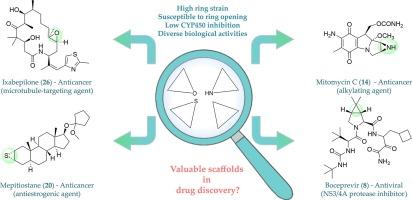环状药物化学:三元环在药物发现中的重要性。
IF 3.3
3区 医学
Q2 BIOCHEMISTRY & MOLECULAR BIOLOGY
引用次数: 0
摘要
基于支架的药物设计是一种系统而有效的方法,可促进新型药物的开发,因此在制药领域的地位日益突出。关键支架的确定为药物化学家的后续研究提供了一个基本框架。越来越多的证据表明,芳香度的增加可能会阻碍口服候选药物的成功开发,因此迫切需要对替代环系统进行更深入的探索,以降低损耗风险。三元环具有独特的特性,因此被广泛应用于药物化学领域。本综述探讨了环丙烷、氮丙啶、硫烷和环氧化物化合物在药物发现中的应用,重点关注它们在已批准药物和候选药物中的作用。特别强调了三元环系统在赋予每个药物分子生物活性方面的重要性。这些化合物不可否认的治疗价值和引人入胜的特性表明它们具有巨大的药理潜力,为将它们纳入新型候选药物的设计提供了理由。本文章由计算机程序翻译,如有差异,请以英文原文为准。

Ringing medicinal chemistry: The importance of 3-membered rings in drug discovery
Scaffold-based drug design has become increasingly prominent in the pharmaceutical field due to the systematic and effective approach through which it facilitates the development of novel drugs. The identification of key scaffolds provides medicinal chemists with a fundamental framework for subsequent research. With mounting evidence suggesting that increased aromaticity could impede the chances of developmental success for oral drug candidates, there is an imperative need for a more thorough exploration of alternative ring systems to mitigate attrition risks. The unique characteristics exhibited by three-membered rings have led to their application in medicinal chemistry. This review explores the use of cyclopropane-, aziridine-, thiirane-, and epoxide-containing compounds in drug discovery, focusing on their roles in approved medicines and drug candidates. Specifically, the importance of the three-membered ring systems in rending biological activity for each drug molecule was highlighted. The undeniable therapeutic value and intriguing features presented by these compounds suggest significant pharmacological potential, providing justification for their incorporation into the design of novel drug candidates.
求助全文
通过发布文献求助,成功后即可免费获取论文全文。
去求助
来源期刊

Bioorganic & Medicinal Chemistry
医学-生化与分子生物学
CiteScore
6.80
自引率
2.90%
发文量
413
审稿时长
17 days
期刊介绍:
Bioorganic & Medicinal Chemistry provides an international forum for the publication of full original research papers and critical reviews on molecular interactions in key biological targets such as receptors, channels, enzymes, nucleotides, lipids and saccharides.
The aim of the journal is to promote a better understanding at the molecular level of life processes, and living organisms, as well as the interaction of these with chemical agents. A special feature will be that colour illustrations will be reproduced at no charge to the author, provided that the Editor agrees that colour is essential to the information content of the illustration in question.
 求助内容:
求助内容: 应助结果提醒方式:
应助结果提醒方式:


